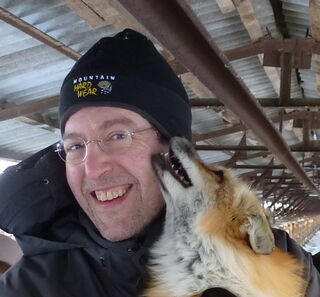Stress
How to Tame a Fox and (Maybe) Domesticate a Human
Domesticated foxes and the audacious idea that humans are self-domesticated.
Posted March 26, 2021 Reviewed by Devon Frye
Key points
- For the last sixty-one years, a team of dedicated Russian geneticists have been breeding the friendliest foxes to study the process of domestication.
- In the late 1970s/early 1980s, the findings from the fox domestication experiment led Dmitri Belyaev to hypothesize that humans are self-domesticated.
- Recent work from biology, anthropology, and psychology suggests Belyaev may have been correct—that we indeed are the product of self-domestication.
This marks my fourth Psychology Today post on a remarkable experiment in evolution that has been underway in Novosibirsk, Russia for the last sixty-one years. Researchers have been, year after year, preferentially breeding the friendliest-toward-human foxes to study the process of domestication in real-time. The results of this experiment have revolutionized not only the way scientists think about domestication, but about our own evolution as humans.
As a Ph.D. student studying evolution and behavior in the late 1980s, I learned of the famous silver fox domestication experiment which, at that point, had been going in Siberia for thirty years. Fast forward to 2010, and as a professor whose interests had turned to the history of science, this experiment took hold of me.
I took a chance and emailed Lyudmila Trut, who had been leading the fox experiment since its inception in 1959. I told Lyudmila I would love to work with her to tell the story of this remarkable experiment to a broad audience. She liked the idea and we began working on our book, How to Tame a Fox and Build a Dog: A Siberian Tale of Jump Started Evolution.
Initially, we exchanged hundreds of emails. Then in 2011, we arranged for me to visit her, the foxes, and the whole fox research team in Novosibirsk. In January of 2012, I found myself at the fox farm holding one of those domesticated foxes in my arms. It was a life-changing experience. Within five seconds, it was licking my face and nibbling my ear. And the hundreds of other domesticated foxes, right there, in front of my eyes, were equally loving. And they looked and acted eerily like cuddly lap dogs.

The silver fox domestication experiment, which continues to this day, was the brainchild of Trut’s mentor, Dmitri Belyaev. Belyaev was interested in understanding the domestication of wolves to dogs, but rather than use wolves, he used silver foxes (Vulpes vulpes) as his subjects.
Based on his reading of Darwin’s The Variation of Animals and Plants Under Domestication and his own interactions with domesticated animals, Belyaev knew that domesticated species tend to share a suite of characteristics that include floppy ears, short/curly tails, juvenilized facial and body features, reduced stress hormone levels, mottled fur, and relatively long reproductive seasons. Today, that suite of traits is called the domestication syndrome.
We have domesticated species for many reasons, including transportation, food, companionship, and protection; but no matter what domesticated species are selected for, over time, they begin to display traits in the domestication syndrome. Belyaev wanted—needed—to know why.
He hypothesized that the early stages of all animal domestication events involved choosing the calmest, most prosocial-toward-human animals—the tamest animals. All of the traits in the domestication syndrome were somehow, though Belyaev didn’t know how, genetically linked to genes associated with tameness.
In 1959, he recruited Trut to put those ideas to the test. They and their team developed a scale for scoring friendliness to humans. How a fox scored on this scale was the only criteria for selecting foxes to parent the next generation. Every fox generation, Trut (and eventually a team of scientists working with her) tested (and continue to test) hundreds of foxes, and the tamest 10 percent were selected to parent the next generation.
Starting with almost wild foxes, within six generations, selection based on tame behavior produced a small number of foxes that licked the hands of experimenters, could be picked up and petted, whined when humans departed, and wagged their tails when humans approached. In the earliest years of the experiment, the tamest of the foxes made up a tiny proportion (about 2 percent) of the animals in the experiment; in 2021, they make up more than 75 percent of the experimental population.
By the late 1970s/early 1980s, the findings from the fox domestication experiment that he and Trut were running led Belyaev to propose the audacious idea that we humans have domesticated ourselves, by selecting tame mates and tame groupmates. He discussed this idea in two papers, the latter of which was a keynote speech at the XV International Genetics Congress in 1984.
Belyaev proposed that “the social environment created by man himself has become for him quite a new ecological milieu.” This led to new natural selection pressures, and he hypothesized that “under these conditions, selection required from individuals some new properties: obedience to the requirements and traditions of the society, i.e., self-control in social behavior.” In particular, humans who were better able to cope with the stress, to stay calm rather than striking out in aggression, had the selective advantage. “One can hardly doubt,” Belyaev noted, “that the ‘word’ and its meaning has become for man an incomparably stronger stressful factor than a club blow for a Neanderthal man,” favoring behaviors such as selecting calmer, “tamer” mates, and groupmates.
Much work needs to be done, but today there is a small, but growing, literature on human self-domestication. Comparative work on humans and other primates has found that we display many of the behavioral and hormonal signatures of a self-domesticated species. Other studies have found that humans show feminization of facial features compared to our species and recent molecular genetic studies of neural crest cells suggest a possible mechanism. Compared to other primates, we also have a prolonged juvenile stage and display relative juvenilized traits for longer periods of time.
For more on human self-domestication, I suggest two wonderful recent books on that subject: Richard Wrangham’s The Goodness Paradox: The Strange Relationship Between Virtue and Violence in Human Evolution and Brian Hare and Vanessa Woods' Survival of the Friendliest: Understanding our Origins and Rediscovering our Common Humanity. Together these two books use evidence from evolution, anthropology, psychology, and other disciplines to make the tantalizing case that by selecting the calmest mates and the most cooperative groupmates, and by punishing those who violate prosocial norms, we have, over the eons, domesticated ourselves.
Lyudmila Trut recently celebrated her 87th birthday and her 61st year leading the remarkable silver fox work that has revolutionized not only our understanding of domestication, but our understanding of ourselves. I can’t wait to see what the next sixty-one years of the experiment teach us.
It’s been seven years since I visited the fox farm a second time in 2014. I miss all my friends there, both human and fox.
References
Belyaev, D.K. Genetics, society and personality. In V.L. Chopra (editor), New Frontiers: Proceedings of the XV International Congress of Genetics (Oxford University Press), 1984.
Belyaev, D.K. On some factors in the evolution of hominids. Voprosy Filosofii, 1981.
Darwin, C. The Variation of Animals and Plants Under Domestication (J. Murray), 1868.
Dugatkin, L.A., and Trut, L.N. How to Tame a Fox {and Build a Dog} (University of Chicago Press), 2017.
Hare, B. and Woods, V. Survival of the Friendliest: Understanding our Origins and Rediscovering our Common Humanity (Penguin books), 2020.
Wilkins, A.S., Wrangham, R., and Fitch, W.M. The “domestication syndrome” in mammals: a unified explanation based on neural crest cell behavior and senetics. Genetics 197, 795-808.
Wrangham, R. The Goodness Paradox: The Strange Relationship Between Virtue and Violence in Human Evolution (Pantheon Books), 2019.




